Sleep apnea is a serious sleep disorder that affects millions of people worldwide. It occurs when breathing repeatedly stops and starts during sleep, leading to poor sleep quality and potential health risks.
Treatment options for sleep apnea range from lifestyle changes to medical devices and surgical procedures.
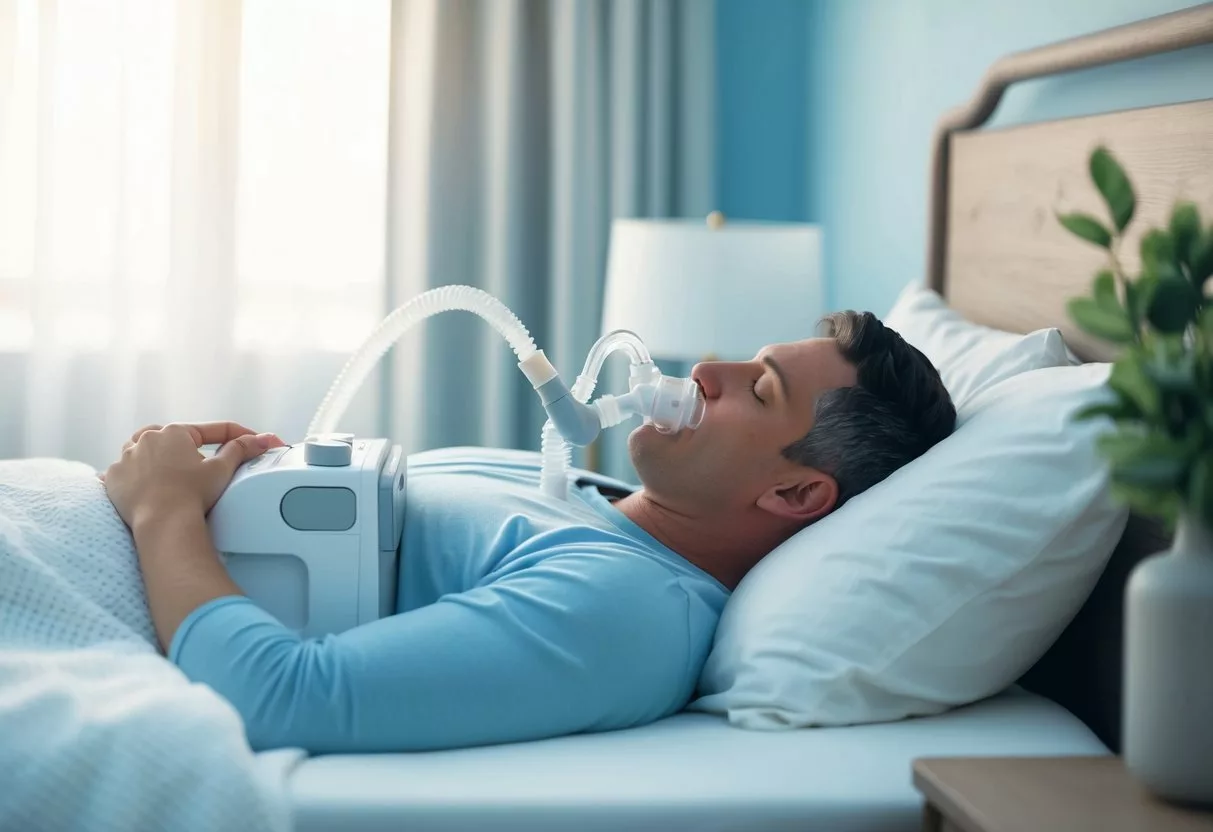
Many people with sleep apnea use CPAP machines to keep their airways open while sleeping. These devices deliver a steady stream of air through a mask worn over the nose or mouth.
For those who find CPAP uncomfortable, other options exist. Oral appliances can help reposition the jaw and tongue to improve airflow. Some patients may benefit from weight loss, yoga, or adjusting sleep positions.
Exciting new developments in sleep apnea treatment are emerging. Researchers are working on a pill that could offer CPAP-free nights for those with mild to moderate sleep apnea. This medication aims to keep airways open and improve sleep quality without the need for external devices.
Understanding Sleep Apnea

Sleep apnea is a serious sleep disorder that affects breathing during sleep. It can lead to health issues if left untreated. There are different types of sleep apnea with distinct causes and symptoms.
Defining Sleep Apnea
Sleep apnea is a condition where breathing repeatedly stops and starts during sleep. These pauses in breathing can last from a few seconds to minutes and may occur 30 times or more per hour.
The brain and body may not get enough oxygen during these episodes, leading to poor sleep quality and daytime tiredness. Sleep apnea often goes undiagnosed because its main symptoms occur during sleep. Many people don’t realize they have it until a bed partner notices the signs.
Types of Sleep Apnea
There are two main types of sleep apnea:
- Obstructive Sleep Apnea (OSA): This is the most common type. It happens when throat muscles relax and block the airway during sleep.
- Central Sleep Apnea (CSA): This type occurs when the brain doesn’t send proper signals to the muscles that control breathing.
Some people have a combination of both types, called complex sleep apnea syndrome.
Symptoms of Sleep Apnea
Common sleep apnea symptoms include:
- Loud snoring
- Gasping for air during sleep
- Dry mouth upon waking
- Morning headaches
- Difficulty staying asleep
- Excessive daytime sleepiness
- Irritability or mood changes
- Difficulty concentrating
Children with sleep apnea may wet the bed, have poor school performance, or show behavior problems.
Causes of Obstructive and Central Sleep Apnea
Obstructive Sleep Apnea is often caused by:
- Excess weight
- Large tonsils or adenoids
- Certain jaw or facial structures
- Decreased muscle tone in airway muscles
Risk factors for OSA include obesity, smoking, alcohol use, and family history.
Central Sleep Apnea can be caused by:
- Heart disorders
- Stroke
- Brain tumors
- Certain medications
CSA is more common in older adults and people with heart disorders or who use opioid medications.
Both types of sleep apnea can lead to serious health issues like high blood pressure and type 2 diabetes if left untreated.
Diagnosing Sleep Apnea
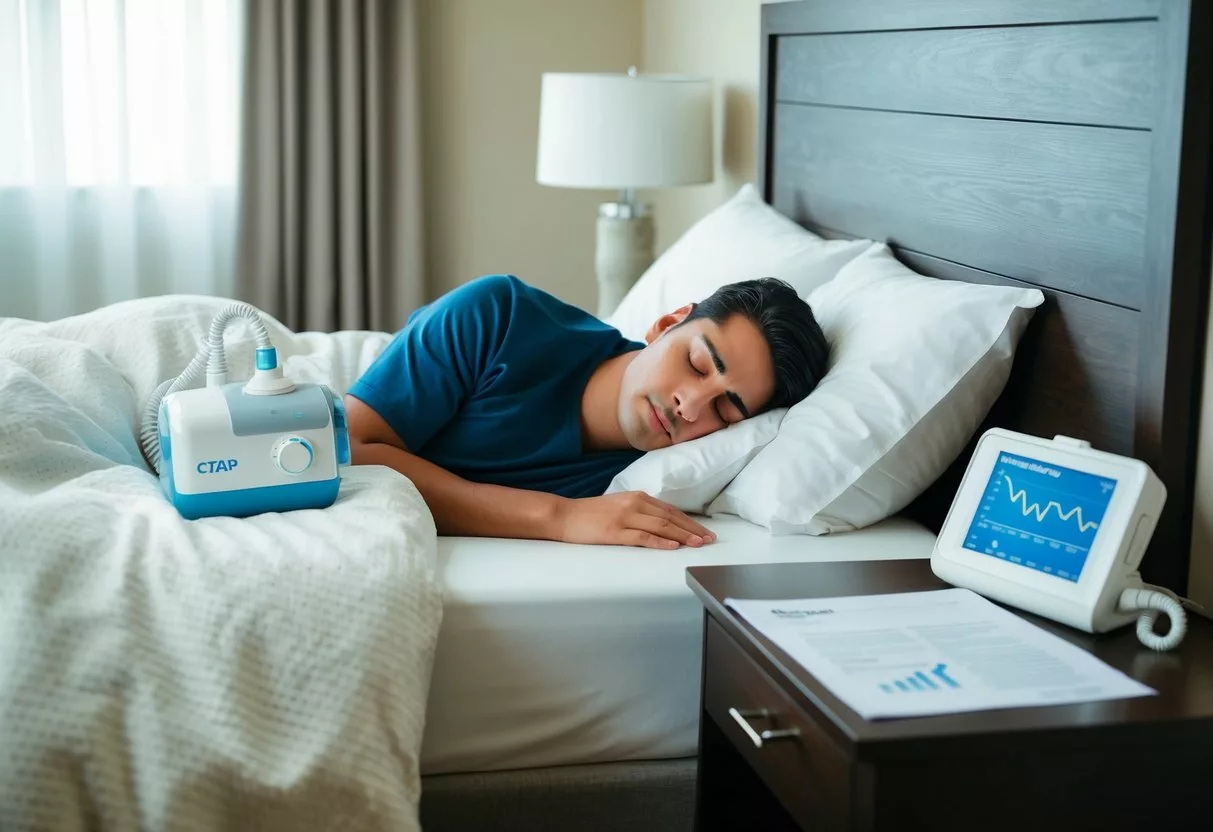
Getting the right diagnosis for sleep apnea is crucial. Doctors use several methods to check if a person has this sleep disorder. These include overnight tests, oxygen level checks, and expert evaluations.
Sleep Studies and Polysomnography
Sleep studies are the main way to diagnose sleep apnea. The most thorough type is polysomnography. This test tracks brain waves, eye movements, and muscle activity during sleep. It also measures breathing, heart rate, and blood oxygen levels.
Polysomnography happens in a sleep lab. A patient stays overnight while connected to sensors. These sensors record data as the person sleeps. The test can show how often breathing stops or slows down.
Home sleep tests are another option. They are simpler but still track breathing and oxygen levels. These tests are more comfortable for some people. But they may miss milder cases of sleep apnea.
Evaluating Blood Oxygen Levels
Blood oxygen levels are key in diagnosing sleep apnea. When breathing stops, oxygen in the blood drops. Doctors look for these drops as a sign of sleep apnea.
A device called a pulse oximeter measures oxygen levels. It clips onto a finger or earlobe. The oximeter tracks oxygen levels all night long.
Normal oxygen levels are 95% to 100%. In sleep apnea, levels can drop below 90%. These drops, called desaturations, help confirm a diagnosis.
Consultation with a Sleep Specialist
A sleep specialist plays a big role in diagnosing sleep apnea. They review symptoms and medical history. They also check for risk factors like obesity or large neck size.
The specialist may do a physical exam. They look at the mouth, nose, and throat. This can show if anything is blocking the airway.
After tests are done, the specialist reviews the results. They count how many times breathing stops or slows per hour. This number helps decide if a person has sleep apnea and how severe it is.
Non-Surgical Treatments
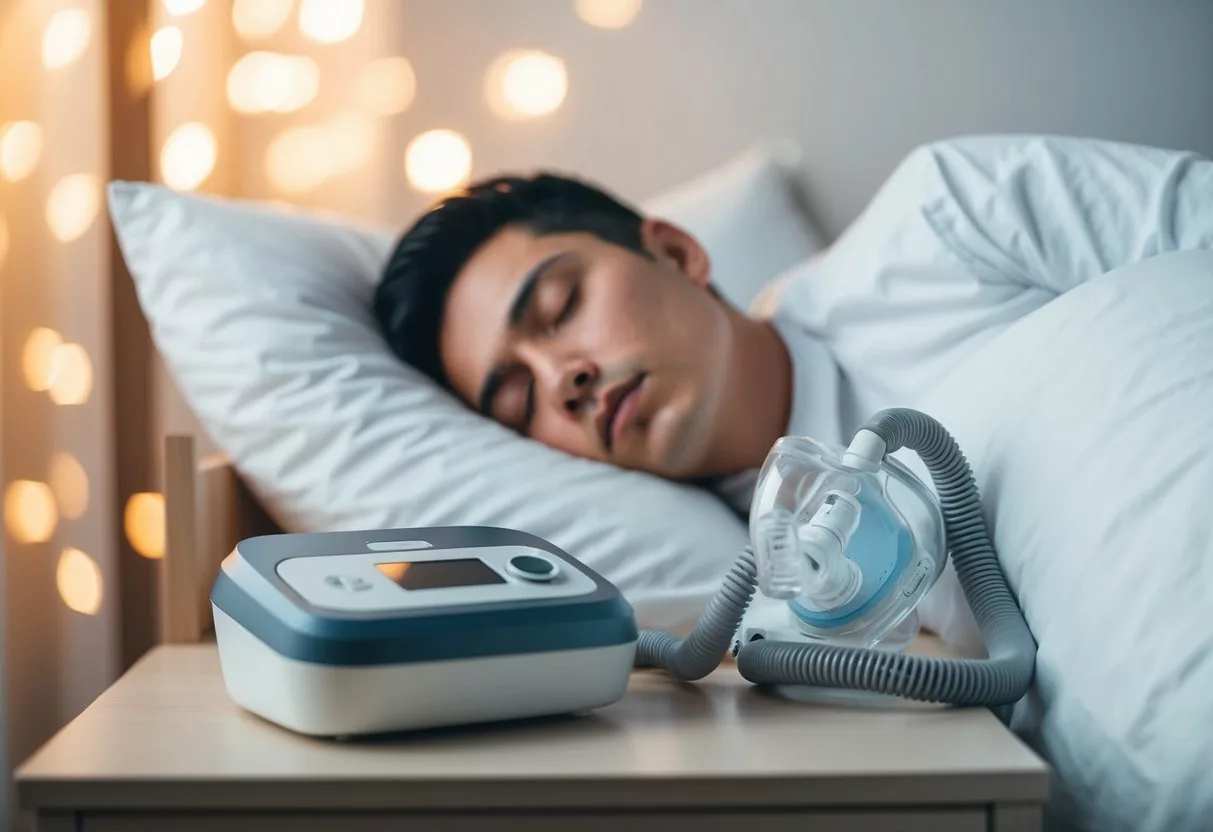
Sleep apnea can often be managed without surgery. Several non-invasive options exist to help keep airways open during sleep and improve breathing.
Positive Airway Pressure Devices
Continuous positive airway pressure (CPAP) is a common treatment for sleep apnea. A CPAP machine delivers pressurized air through a mask worn over the nose or mouth. This air keeps the airway open, preventing pauses in breathing.
Other types of positive airway pressure devices include:
- Bi-level positive airway pressure (BiPAP)
- Auto-adjusting positive airway pressure (APAP)
These machines adjust air pressure based on breathing patterns. Some people find them more comfortable than standard CPAP devices.
Oral Appliances and Devices
Dental devices can help manage mild to moderate sleep apnea. These appliances move the jaw or tongue forward to keep airways open.
Types of oral appliances include:
- Mandibular advancement devices
- Tongue retaining devices
Custom-fitted oral appliances are more effective than over-the-counter options. A dentist or orthodontist can create a device tailored to the patient’s mouth shape.
Lifestyle Changes and Weight Loss
Simple lifestyle adjustments can significantly improve sleep apnea symptoms. Weight loss is particularly effective for those with obesity-related sleep apnea.
Other helpful changes include:
- Quitting smoking
- Avoiding alcohol before bed
- Sleeping on your side
Regular exercise and a healthy diet support weight loss efforts. Even modest weight reduction can lead to noticeable improvements in sleep quality.
Nasal strips or dilators can help open nasal passages. This may reduce snoring and improve airflow for some people with mild sleep apnea.
Advanced Therapies for Sleep Apnea
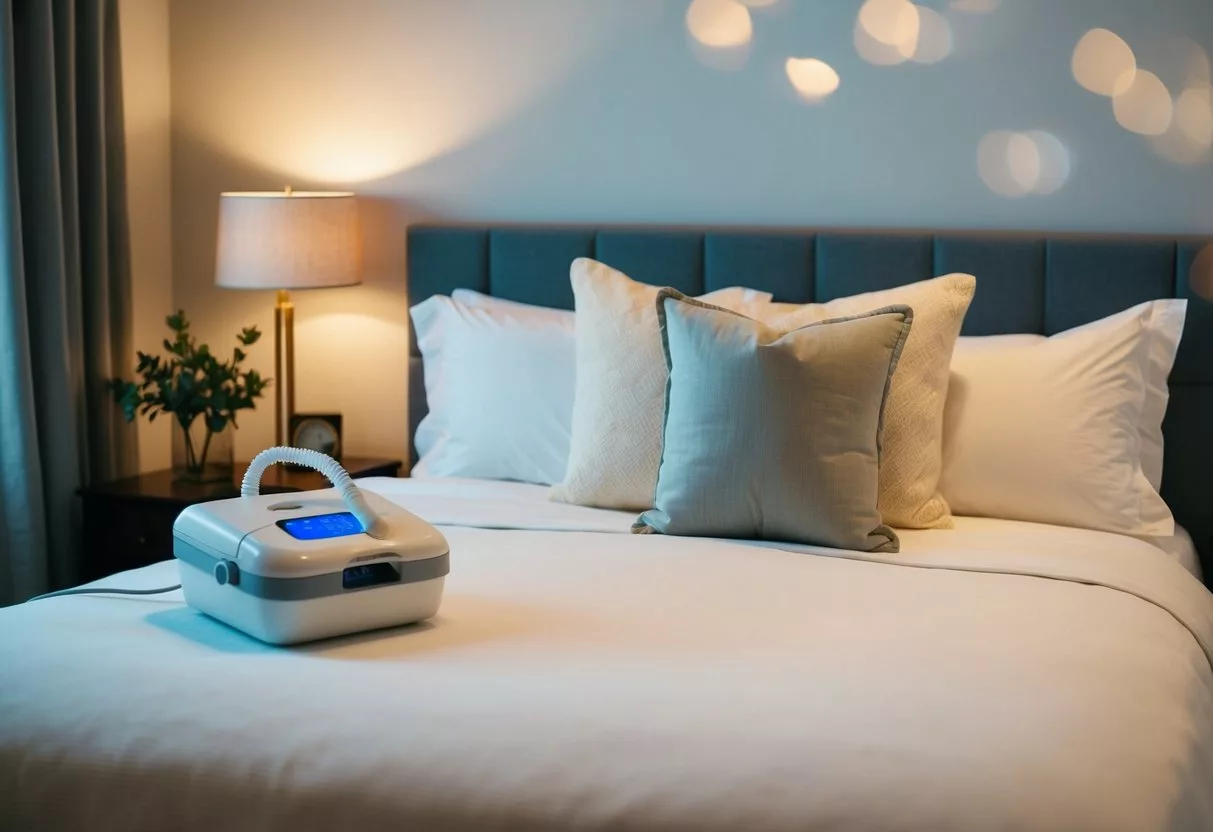
Sleep apnea patients now have more options beyond CPAP. New treatments target the root causes of airway obstruction during sleep.
Surgical Options
Surgery can help some people with sleep apnea. Uvulopalatopharyngoplasty (UPPP) removes excess tissue in the throat. This widens the airway.
Maxillomandibular advancement moves the jaw forward. It creates more space for breathing. This surgery works well for some patients.
Nasal surgeries can also help. They fix blockages in the nose, making breathing easier at night.
Doctors choose surgeries based on each patient’s needs. They look at the specific causes of the sleep apnea.
Upper Airway Stimulation
This newer therapy uses a small device. It’s placed under the skin of the chest and monitors breathing patterns during sleep.
When needed, it sends mild pulses to the tongue nerve. This keeps the airway open. It’s for people who can’t use CPAP.
Studies show it can reduce sleep apnea symptoms. Many patients report better sleep quality. It’s an option for those who haven’t found success with other treatments.
Experimental Treatments and Clinical Trials
Scientists are always looking for new ways to treat sleep apnea. Clinical trials test new drugs and therapies.
One promising drug is AD109. It combines two medicines. Early results show it might help some patients sleep without CPAP.
Other trials look at new devices and surgeries. Some focus on weight loss methods that could help people with obesity-related sleep apnea.
Patients interested in trials should talk to their doctors. They can find out if any studies are right for them.
Equipment for Sleep Apnea
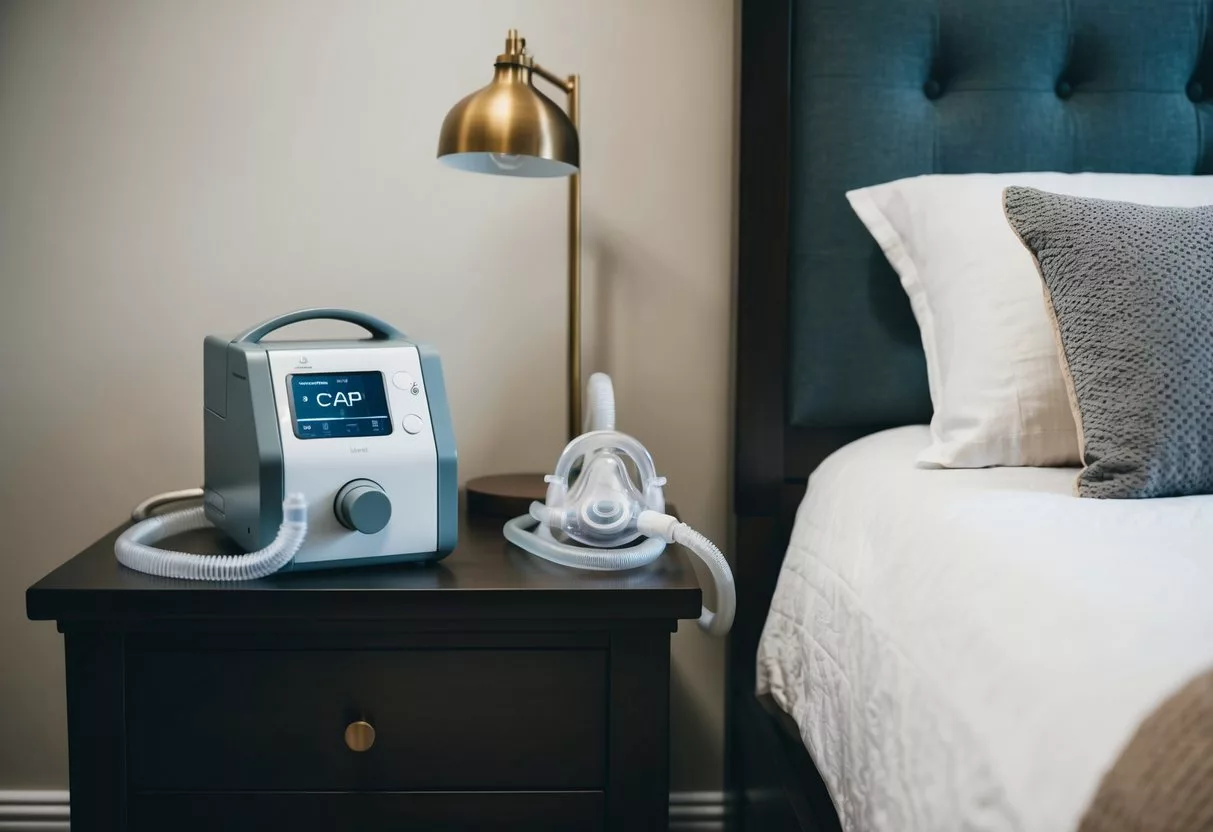
Sleep apnea treatment often involves specialized devices to help patients breathe properly during sleep. These machines provide pressurized air to keep airways open throughout the night.
CPAP and BiPAP Machines
CPAP (Continuous Positive Airway Pressure) machines are the most common sleep apnea devices. They deliver a steady stream of air through a mask worn over the nose or mouth.
CPAP therapy helps keep airways open, preventing pauses in breathing. The air pressure can be adjusted to meet each patient’s needs.
BiPAP (Bi-level Positive Airway Pressure) machines offer two pressure levels – one for inhaling and a lower one for exhaling. This can be more comfortable for some users who struggle with CPAP.
Both types come in various sizes and styles. Some are designed for travel, while others have advanced features like humidity control.
Understanding Bi-Level and Auto-Adjusting Devices
Bi-level devices, also known as BPAP, provide two distinct pressure settings. This can help patients who need higher pressure to inhale but find it difficult to exhale against constant pressure.
APAP (Automatic Positive Airway Pressure) machines automatically adjust air pressure throughout the night. They respond to changes in the user’s breathing patterns.
These auto-adjusting devices can be beneficial for patients whose pressure needs vary. They often provide more comfort and better therapy compliance.
Some machines combine CPAP, BiPAP, and APAP functions. This allows for customized treatment as a patient’s needs change over time.
Maintenance and Care for PAP Machines
Regular cleaning is crucial for all PAP (Positive Airway Pressure) devices. This includes the machine, tubing, mask, and any filters.
Most parts should be washed weekly with mild soap and warm water. Masks often need daily cleaning to remove oils from skin contact.
Filters should be checked monthly and replaced as needed. Some machines have both disposable and reusable filters.
Water in humidifier chambers should be changed daily. Use distilled water to prevent mineral buildup.
Annual maintenance checks by a healthcare provider or equipment supplier are recommended. This ensures the machine is working correctly and delivering the right pressure.
Proper care extends the life of the equipment and helps maintain effective therapy. It also reduces the risk of respiratory infections from contaminated parts.
Sleep Apnea and Associated Health Conditions
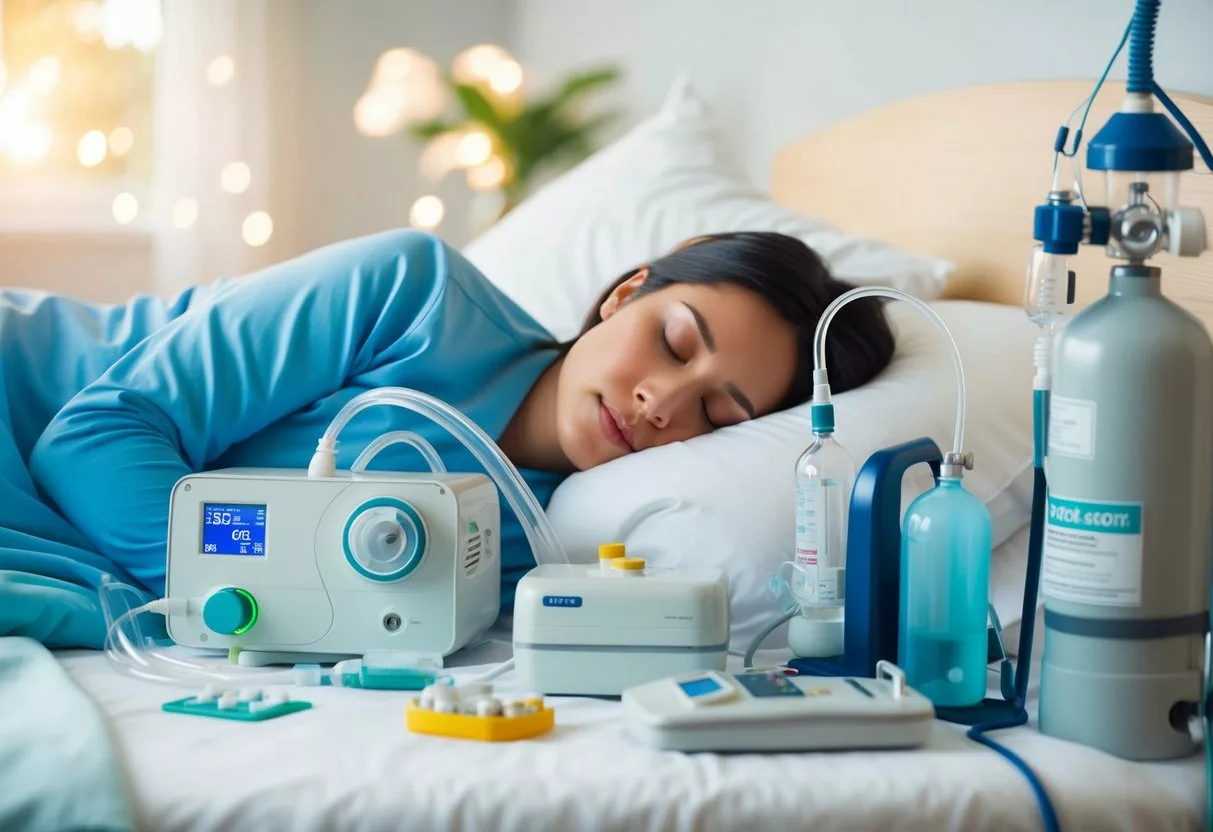
Sleep apnea can lead to serious health issues beyond just poor sleep. It’s linked to heart problems, metabolic disorders, and mental health concerns.
Sleep Apnea and Heart Disease
Sleep apnea puts extra stress on the heart. It can cause high blood pressure and increase the risk of heart attacks. People with sleep apnea often have irregular heartbeats.
The repeated drops in oxygen levels during sleep can damage blood vessels. This raises the chances of developing heart disease. Treating sleep apnea may help lower blood pressure and improve heart health.
Correlation with Metabolic Conditions
Sleep apnea and type 2 diabetes often occur together. The oxygen drops from sleep apnea can affect how the body uses insulin. This can lead to insulin resistance and higher blood sugar levels.
People with sleep apnea are more likely to be overweight. Extra weight can make sleep apnea worse. It’s a cycle that’s hard to break. Treating sleep apnea can help improve blood sugar control and weight management.
Sleep Apnea and Mental Health
Sleep apnea can have a big impact on mental health. Poor sleep quality leads to daytime tiredness and mood changes. People with sleep apnea often feel irritable and have trouble focusing.
The condition is linked to higher rates of depression and anxiety. Lack of oxygen during sleep can affect brain function. This may lead to memory problems and difficulty thinking clearly.
Getting proper sleep apnea treatment can greatly improve mental well-being. It can boost mood, increase energy, and help with focus during the day.
Positional Therapy
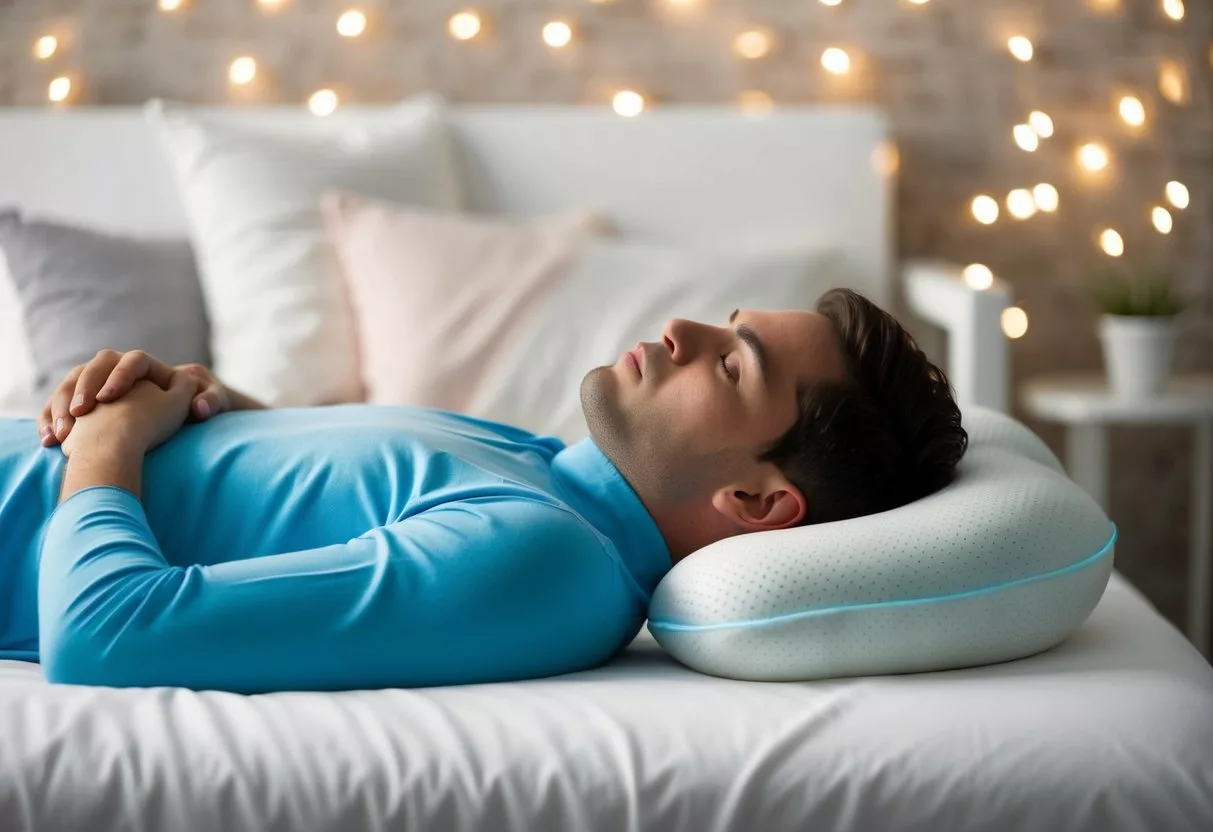
Positional therapy helps people with sleep apnea breathe better at night. This simple approach changes sleeping positions to keep airways open and reduce breathing problems.
Benefits of Positional Therapy
Positional therapy for obstructive sleep apnea can improve sleep quality. It lowers the number of breathing pauses per hour, called the apnea-hypopnea index (AHI). This leads to better rest and less daytime sleepiness.
The therapy is easy to use at home. It doesn’t require machines or devices to wear while sleeping. This makes it more comfortable for some people than other treatments.
Positional therapy works well for those whose sleep apnea gets worse when lying on their back. By avoiding this position, they can breathe more easily all night long.
Implementing Positional Changes
To start positional therapy, people need to avoid sleeping on their backs. Special pillows or wearable devices can help keep sleepers on their sides.
Tennis balls sewn into the back of pajamas is a simple DIY method. This makes back-sleeping uncomfortable, encouraging side-sleeping instead.
Some people use wedge pillows to elevate their upper body. This can open airways and improve breathing patterns during sleep.
Tracking sleep positions with a smartphone app or wearable device can help. This shows if the therapy is working and if changes are needed.
Regular practice helps make new sleep positions feel natural over time. Patience and consistency are key for success with positional therapy.
Lifestyle and Behavioral Modification
Making changes to daily habits can greatly improve sleep apnea symptoms. Simple adjustments in diet, exercise, and certain behaviors can lead to better sleep quality and overall health.
Impact of Lifestyle on Sleep Apnea
Obesity plays a major role in sleep apnea. Excess weight puts pressure on the airway, making it more likely to collapse during sleep.
Weight loss can significantly reduce sleep apnea symptoms. Even a 10% reduction in body weight can lead to noticeable improvements.
Regular exercise helps in multiple ways. It aids weight loss, boosts energy levels, and improves oxygen intake. Exercise also enhances sleep quality and reduces daytime sleepiness.
Healthy eating habits are crucial. A balanced diet rich in fruits, vegetables, and lean proteins supports weight management. It’s best to avoid large meals close to bedtime.
Quitting Smoking and Alcohol Consumption
Smoking irritates the throat and increases inflammation. This can worsen sleep apnea symptoms by narrowing the airway.
Quitting smoking can lead to significant improvements in sleep quality. It reduces airway irritation and inflammation.
Alcohol relaxes throat muscles, potentially causing airway collapse during sleep. It’s advisable to limit alcohol intake, especially before bedtime.
Reducing alcohol consumption can help decrease snoring and improve overall sleep quality. It’s best to avoid alcohol at least 3 hours before sleep.
Combining these lifestyle changes can lead to substantial improvements in sleep apnea symptoms. They may even reduce the need for other treatments in some cases.
Potential Complications of Sleep Apnea
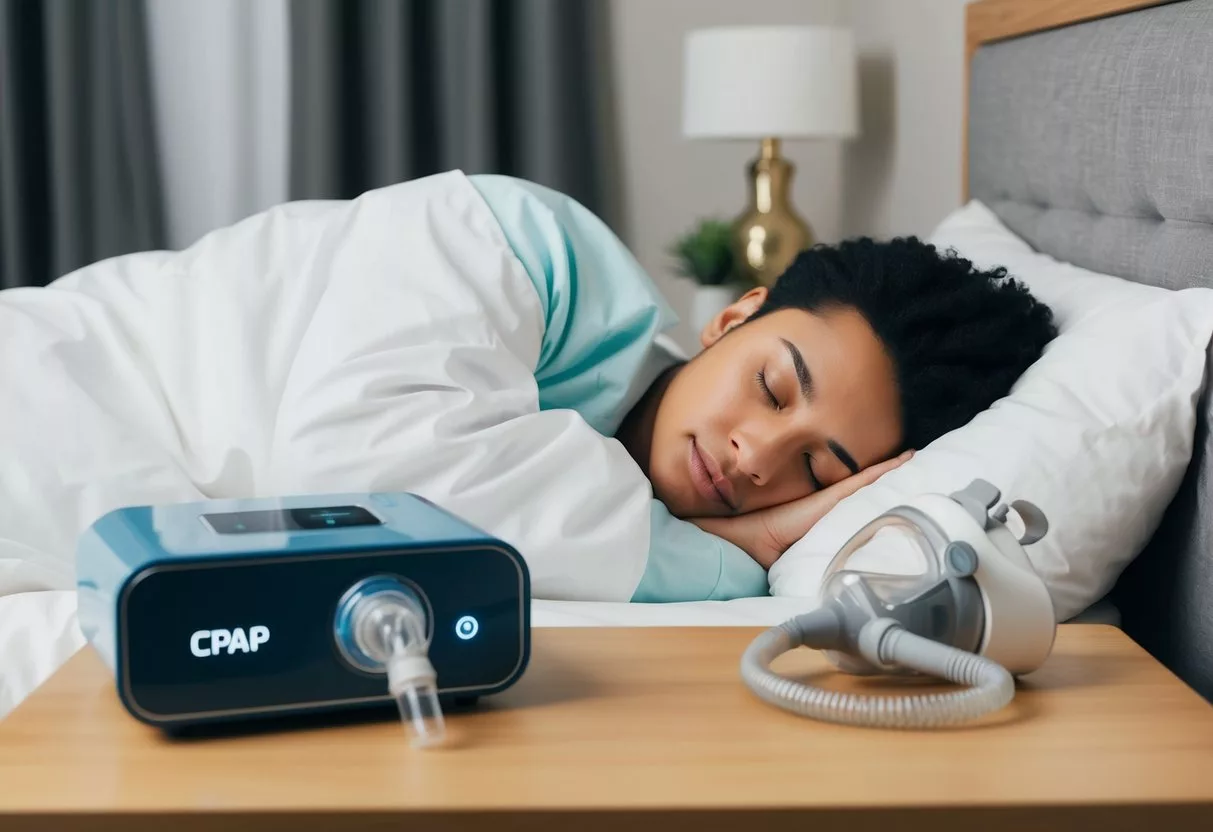
Sleep apnea can lead to serious health issues and affect daily functioning. When left untreated, this condition can have wide-ranging impacts on both physical and mental well-being.
Risks of Untreated Sleep Apnea
Untreated sleep apnea can cause high blood pressure and increase the risk of heart problems. The repeated drops in blood oxygen levels during sleep can strain the cardiovascular system.
People with sleep apnea may also face a higher chance of:
- Stroke
- Type 2 diabetes
- Liver problems
- Complications with medications and surgery
Sleep apnea can worsen existing health conditions. It may lead to irregular heartbeats and increase the risk of heart attacks.
Impacts on Daily Life
Excessive daytime sleepiness is a common symptom of sleep apnea. This can affect work performance, driving safety, and overall quality of life.
Other daily impacts include:
- Morning headaches
- Difficulty concentrating
- Mood changes and irritability
- Dry mouth upon waking
Sleep apnea can strain relationships due to loud snoring and mood issues. It may also lead to decreased libido and sexual dysfunction.
The chronic fatigue caused by sleep apnea can limit a person’s ability to enjoy social activities and hobbies. This may result in feelings of isolation or depression.
Choosing the Right Treatment
Selecting an effective sleep apnea treatment involves careful consideration of various options. A personalized approach, guided by medical professionals, helps ensure the best outcomes for each patient.
Evaluating Treatment Options
Sleep apnea treatment options range from lifestyle changes to medical devices and surgical interventions. CPAP (Continuous Positive Airway Pressure) therapy is often the first-line treatment. It uses a machine to deliver air pressure through a mask while sleeping.
For mild cases, an oral device may be recommended. These appliances help reposition the jaw or tongue to keep airways open during sleep.
In some cases, surgery might be necessary to correct anatomical issues contributing to sleep apnea. Options include nasal surgery or uvulopalatopharyngoplasty (UPPP).
Weight loss and positional therapy can also be effective for some patients. Avoiding alcohol and sedatives before bed may help reduce symptoms.
Personalized Sleep Apnea Management
A sleep specialist plays a crucial role in developing a tailored treatment plan. They consider factors such as the severity of sleep apnea, overall health, and patient preferences.
Regular follow-ups are essential to monitor progress and adjust treatment as needed. Patients may need to try different options before finding the most effective solution.
Combination therapy, using multiple treatment methods, may be recommended for some individuals. This approach can address different aspects of sleep apnea simultaneously.
Adherence to prescribed treatments is key for successful management. Patients should communicate any difficulties or side effects to their healthcare provider promptly.
Frequently Asked Questions
Sleep apnea solutions range from medical devices to lifestyle changes. New treatments emerge regularly, while traditional methods remain effective for many. Proper diagnosis and personalized approaches are key to managing this condition.
What are the latest advancements in treating sleep apnea?
Recent innovations include upper airway stimulation devices that help keep airways open during sleep. These devices are suitable for people who can’t tolerate CPAP machines.
Adaptive servo-ventilation (ASV) is another new technology. It adjusts air pressure based on the patient’s breathing patterns, making it especially useful for complex sleep apnea cases.
How can one manage sleep apnea without using a CPAP machine?
Positional therapy is one option. This involves sleeping on one’s side to prevent airway collapse.
Oral appliances can be effective for mild to moderate cases. These devices help keep the jaw positioned correctly to maintain an open airway.
Weight loss can significantly improve sleep apnea symptoms in overweight individuals. Even a small reduction in weight can make a difference.
Is it possible for sleep apnea to be life-threatening?
Yes, untreated sleep apnea can lead to serious health problems. It increases the risk of high blood pressure, heart disease, and stroke.
Severe cases can cause sudden cardiac death due to irregular heartbeats. Chronic sleep deprivation from sleep apnea can also lead to accidents while driving or operating machinery.
What surgical options are available for sleep apnea treatment?
Uvulopalatopharyngoplasty (UPPP) is a common surgery. It removes excess tissue in the throat to widen the airway.
Maxillomandibular advancement is another surgery. It moves the jaw forward to enlarge the space behind the tongue and soft palate. This can be very effective for some patients.
Hypoglossal nerve stimulation is a third option. It involves implanting a device to stimulate the nerve that controls tongue movement, keeping the airway open.
What self-care strategies can improve sleep apnea symptoms?
Maintaining a healthy sleep schedule is crucial. Going to bed and waking up at consistent times helps regulate sleep patterns.
Avoiding alcohol and sedatives before bedtime can reduce airway relaxation and improve breathing during sleep.
Using a humidifier can help with dry mouth and nasal passages, making sleep more comfortable.
How is sleep apnea diagnosed effectively?
A sleep study, or polysomnography, is the gold standard for diagnosis. It monitors brain waves, eye movements, heart rate, and blood oxygen levels during sleep.
Home sleep tests are also available. These devices measure breathing patterns, oxygen levels, and heart rate, providing valuable data for diagnosis.
AHI (Apnea-Hypopnea Index) is used to assess sleep apnea severity. It measures the number of breathing interruptions per hour of sleep.